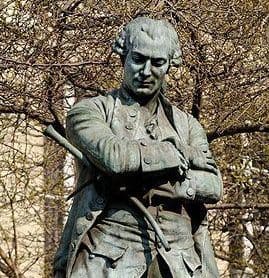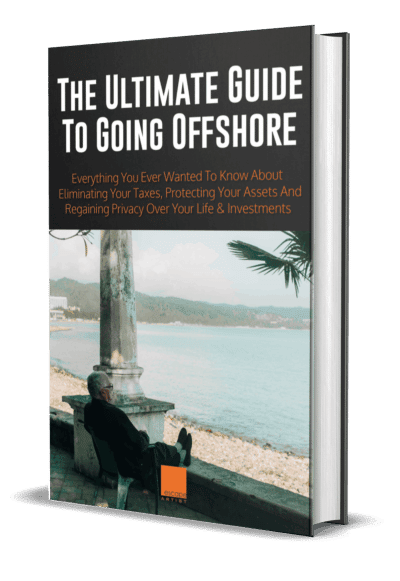Pierre-Augustin Caron de Beaumarchais 1732-1799
Revolution and the Barber of Seville
Paris. Christmas in Paris – what an extraordinary time to be in the City of Light. My wife, Rebel, and I attended Christmas Eve Mass at the Basilica of the Sacré Coeur in Montmartre and Christmas Mass at the Cathedral of Notre Dame.
Each was a moving experience, yet in different ways. In Montmartre (the Mons Martis or Mount of Mars for the Romans), the Basilica was overflowing with an ethnic mélange of worshippers – Christians from India, Africa, China, and all over Europe. The Great Cathedral in the city’s center, by contrast, was filled with French of all ages.
Each was confirmation of Christianity as a balm on humanity’s soul – the reason why people in Europe have begun returning to it. The sophisticates of Europe have long thought Christianity obsolete. It was easy to think this way while Europe got a free ride from America, which provided protection from the Soviet Union during the Cold War, and a free ride from their welfare state governments.
Now the free rides are over, and Europe faces the ancient and now renewed threat of Islam from outside and within. What Europe must also face now, and France in particular, is the consequence of its recent, and its revolutionary, past.
Notre Dame is on an island, the Île de la Cité, in the Seine River. If you cross over the Pont d’Arcole to Paris’ Right Bank and walk for a short block, you will come to one of the city’s most famous streets, the Rue de Rivoli. Walk along it to the left and you will reach the Louvre. Turn right and it eventually becomes the Rue Saint-Antoine, which ends at the Place de la Bastille.
There’s just a traffic circle there now, with cars racing around a tall (154′) column of green bronze topped by a golden statue of a winged Mercury. 227 years ago, there was a huge brooding fortress here, built in the 1370s during the Hundred Years War with England. Louis XIII (1601-1643) turned it into a state prison, which housed but seven prisoners and a handful of guards when it was stormed by a mob on July 14, 1789.
The French Revolution began with a chaotic frenzy of a crazed mob – and no one could see it, nor understand its absurdity, better than a man who lived in a resplendent mansion overlooking the Bastille. No one was better placed than he to grasp the difference between a revolution based on a Christian love for freedom and one based on anti-Christian hate and revenge.
No one – for as he gazed down upon the murderous mob storming the Bastille, he knew the critical role he had personally played in bringing about both the American and French Revolutions. How strange, he thought, that the uneducated son of a poor clockmaker would come to play a pivotal role in history – twice.
So curl up by the fire in a comfy chair with your favorite adult beverage, and let me tell you his incredible story – a story of Revolution and the Barber of Seville.
Pierre-Augustin Caron was born in Paris in 1732, to a father who demanded, as he grew up, he be his slave apprentice. Pierre rebelled by deciding to become a better watchmaker than his father.
The horological dream back then was a compact watch you could carry, rather than a bulky cumbersome clock. The problem was the escapement, the gizmo that converts continuous rotational motion from a gear or spring into a ticking back-and-forth. The “verge” escapement of the day wouldn’t allow for a small flat timepiece.
Experience the Insider community that takes your international lifestyle to the next level. Download your FREE guide
"18 Steps to Implementing Your Plan B" instantly!
So, Pierre taught himself mechanics and the computational math required to invent a far simpler “virgule” escapement that allowed for a revolutionary reduction in a watch’s size while improving its accuracy. It was 1753, he was 21 years old, and made the mistake of showing his invention to a famous watchmaker, Jean-Andre Lepaute, who stole it and claimed the invention was his.
The 21-year-old kid turned out to have a talent for words, and so lacerated Lepaute in a Parisian newspaper that the Academy of Sciences investigated, finding Lepaute guilty of theft. It was the talk of Paris, which reached the ears of the King, Louis XV (1710-1774), who requested to meet Pierre.
At the meeting in the Palace of Versailles, Pierre fascinated the King with the explanation of his invention and presented the King’s mistress, Madame de Pompadour, with the smallest watch ever made – set in a ring one-third of an inch in diameter and one-twelfth of an inch between the cases.
The entire Court was astounded, Pierre was appointed Horloger du Roi (Watchmaker to the King), and he and his father were flooded with orders.
Granted an Entré to the Court, he quickly learned court etiquette and manners. Realizing his education was non-existent, he devoured books on every subject. He was soon a habitué of Paris’ literary cafés and got to know the stars of the French Enlightenment – Diderot, d’Alembert, d’Holbach, and other Encyclopedists. He married a lady, Madeleine Franquet, who had inherited a small wooded property on the outskirts of Paris called Bois-marché.
A common practice at the time was to name yourself after an estate you owned, however small. This Pierre did, altering the spelling a bit, so that he now, in 1756 at age 24, became known as history knows him – Pierre-Augustin Caron de Beaumarchais.
He and Madeleine loved music. She introduced him to the latest instrument in vogue, the harp, which he not only learned to play expertly, but designed a new pedal mechanism which made it far easier to play. The King soon learned of this and requested that Beaumarchais musically instruct his four grown, unmarried daughters.
Handsome, charming, witty, yet always proper with impeccable manners was Beaumarchais, and all four daughters became enamored of him. The richest merchant in France, a financial wizard named Joseph Pâris-Duverney, learned of Pierre’s influence with the princesses and told Beaumarchais of his life dream, an Ecole Militaire, a military academy providing France’s young officers with the finest military training and him, Pâris-Duverney, with a worthy legacy.
What was needed was for it to be officially designated a Royal military academy by the King. Pâris-Duverney would be exceedingly grateful if this were achieved. Beaumarchais took the hint and took the princesses on an exciting outing to the academy to see all the stalwart cadets parading in their splendid uniforms. The princesses raved to the King, who, on August 18, 1760, made a visit himself – and the Royal Military Academy of France was founded.
Pâris-Duverney proceeded to mentor Beaumarchais, whom he discovered had an extraordinary ability to quickly grasp the most intricate financial problems. As the astute protégé of France’s greatest financier, Beaumarchais made investments enabling him to become immensely wealthy.
Now a confidante of Louis XV, the king designated Beaumarchais as his personal secret agent. His first assignment was to suppress the publication in England of a pamphlet that libeled Madame du Barry (Jeanne Becú 1743-1793), who had succeeded Pompadour (Jeanne-Antoinette Poisson 1721-1764) as the Royal Mistress. He went to London, bribed the right people, and succeeded. Subsequent assignments took him throughout Europe.
When the 20-year-old grandson (whose father had died of tuberculosis) of Louis XV succeeded him in 1774, as Louis XVI, the new king gave Beaumarchais an assignment to change history.
Under the guidance of Louis’ foreign minister, the Comte (Count) de Vergennes (Charles Gravier 1717-1787), Beaumarchais was to organize secret French assistance for the rebellion against England emerging in America. It was the best way, Louis had concluded, to weaken France’s most dangerous enemy.
Beaumarchais went to London to meet Benjamin Franklin’s agent, American-born attorney Arthur Lee, and two members of the British Parliament who supported America, John Wilkes and Isaac Barré (for whom the Pennsylvania town of Wilkes-Barre is named).
He proposed to set up a company (what we would call a cutout or shell) in Spain, where he had many business contacts that would transfer French military supplies to America under the guise of selling American agricultural produce in Europe.
They agreed, the King and Vergennes agreed, and the Rodrigue Hortalez et Cie (and Company) was set up in June of 1776. Beaumarchais went from one French port to another, buying and equipping ships, loading them with supplies, and recruiting experienced French military officers to “volunteer” at high pay for the American army. In addition to the millions provided by the King, he spent millions of his own.
The first shipment of 200 cannons, thousands of muskets, and equipment and clothing for 25,000 American soldiers arrived in Portsmouth in July 1777. It proved critical to the American victory at the Battle of Saratoga in October – the turning point in the War of Independence, which enabled France to openly support it rather than in secret, resulting finally in the French fleet bottling up Cornwallis at Yorktown and the English surrender to Washington four years later, in October 1781.
So, it is that we Americans owe our freedom and independence, in part, to the son of a French clockmaker.
Yet, at the very same time Beaumarchais is spending his fortune and energy on freedom for America, he decides to be a playwright and writes one of the most historically successful comic operas of all time, The Barber of Seville. The character of Figaro – barber, philosopher, with his guitar and quick mind resolving any difficulty, his wit piercing any pretense and injustice – captured tout le monde in Paris and all of Europe.
First performed in Paris in February 1775 to a tumultuous reception, a sequel was demanded – which took Beaumarchais a while, as he was busy saving America. Finally, it appeared as The Marriage of Figaro, which the King (after an initial prohibition) allowed to be performed in 1784. Historians ever since have considered it to be the “harbinger of revolution,” while Napoleon described it as “the (French) Revolution in action.”
This is due to Figaro’s famous Soliloquy addressed to the aristocracy of Spain with revolutionary scorn, e.g.:
“Because you are a great lord, you consider yourself a great genius. Noble birth, a great fortune, high rank and offices – all that tends to make one proud. What have you done to deserve these good things? You have condescended to be born, that’s all. You are a commonplace fellow enough in all else; while I, upon my faith, lost in a crowd of obscurities, must use more wisdom and forethought for a bare living than it has taken to govern all Spain for a century.”
The following year (1785), Mozart wrote his immortal opera based on Beaumarchais’ play, changing the scandalous soliloquy into an angry aria against unfaithful wives to placate his emperor, Joseph II of Austria. The Overture is one of the most beloved works of classical music and is familiar to us all.
By the time Beaumarchais witnessed the storming of the Bastille from his magnificent mansion, he realized that he had unleashed the creation of freedom in America – but its opposite in France. He realized too late with the latter that his call for greater justice within the existing order had resulted in the destruction of the entire order by envious hate.
What was the difference? Why had the American Revolution been one of liberation and the French Revolution been one of the guillotine? One reason, Beaumarchais realized, was that the leaders of the American Revolution were Christians and those of the French Revolution were not.
He never forgot this lesson – as he was imprisoned by the revolutionary regime in 1792, managed to escape just before the Reign of Terror began, was hunted by the regime’s agents as he sought refuge throughout Europe, had his property and wealth seized, and died impoverished in 1799.
As we enter this New Year of 2018, it is worth recalling the lesson learned by Beaumarchais at so much expense. A French Revolution must be avoided at all costs – for who knows whose head will be on the chopping block if it isn’t.
This particular Christmas season, it is worth reaffirming that we need a revolution of Christians motivated to regain their God-given freedom to which they have an individual inalienable right. This was the goal of the original American Revolution, and it is why it remains the most successful – indeed the only true – revolution in the history of mankind.
This is the lesson we need to learn in order to regain the freedoms we have now lost – a lesson taught to us by a heroic man who so ironically authored both our War of Independence and the Barber of Seville.
P.S. The photo above is the statue of Beaumarchais on Rue Saint-Antoine, near the Place de la Bastille.
Here is probably the most extensive ebook on Everything You Ever Wanted To Know About Eliminating Your Taxes, Protecting Your Assets And Regaining Privacy Over Your Life And Investments. It is called The Ultimate Guide To Going Offshore.
©2019 Jack Wheeler – republished with permission
Like Our Articles?
Then make sure to check out our Bookstore... we have titles packed full of premium offshore intel. Instant Download - Print off for your private library before the government demands we take these down!







